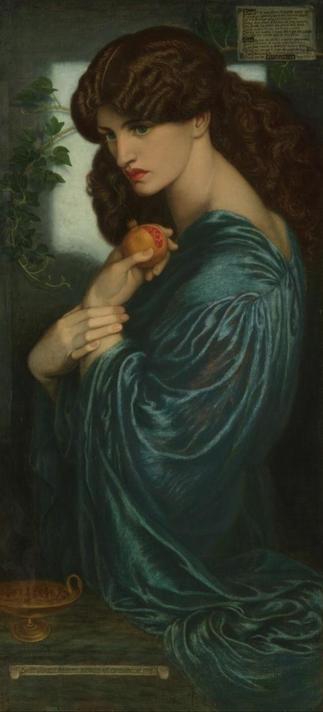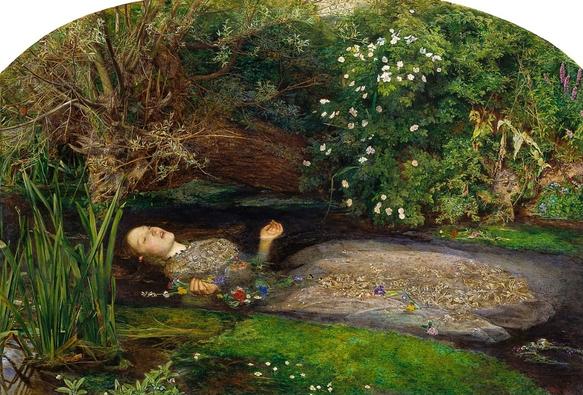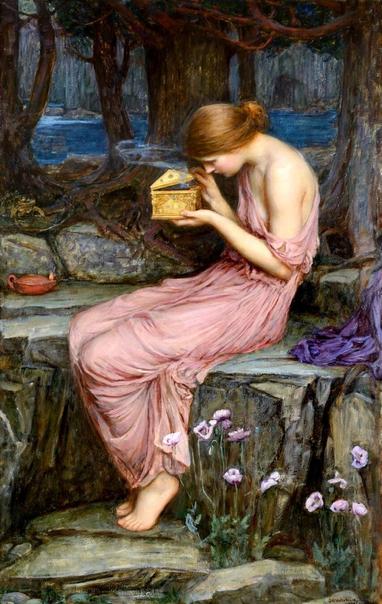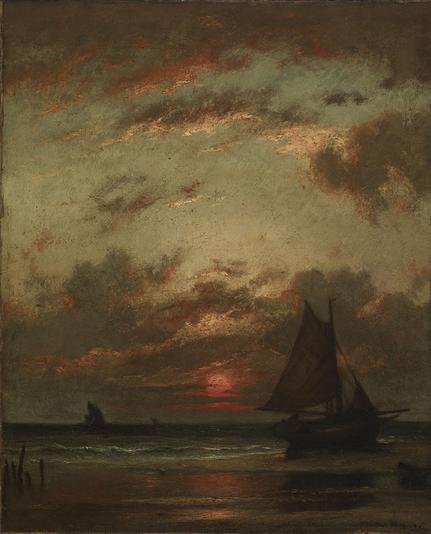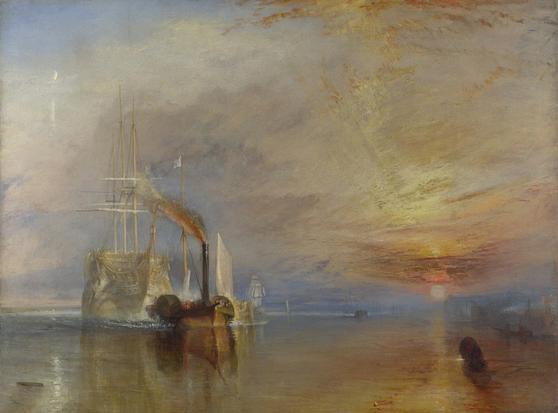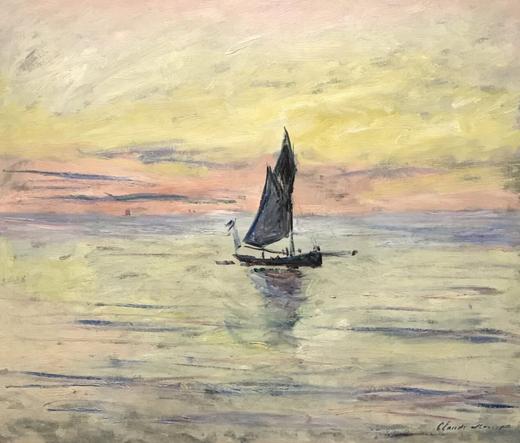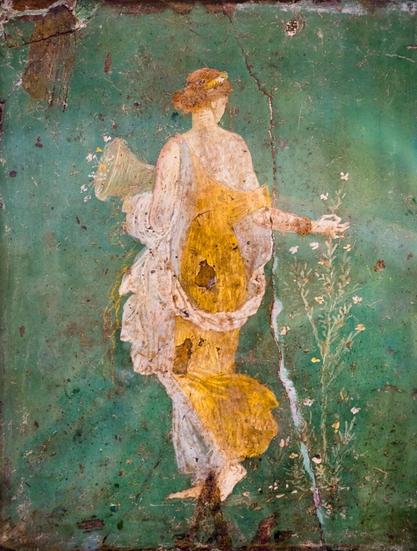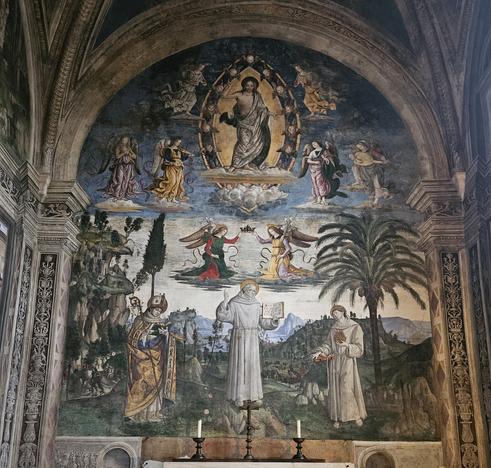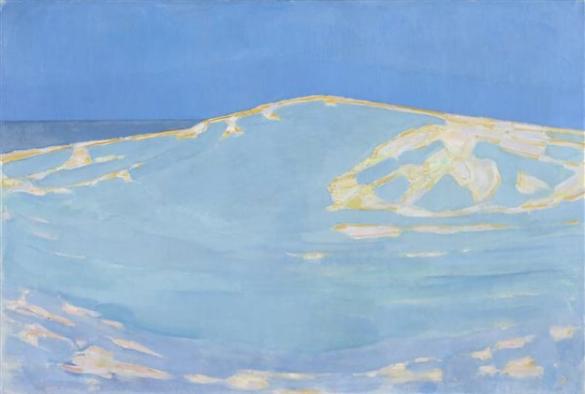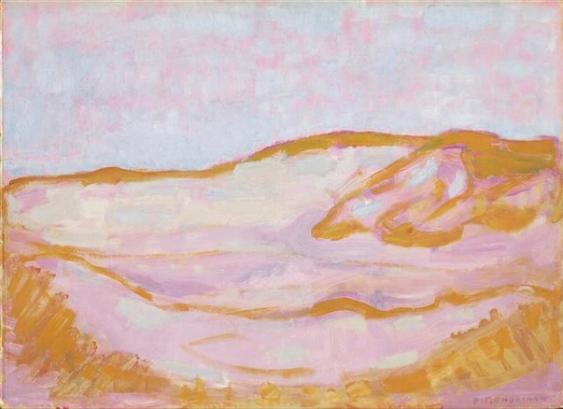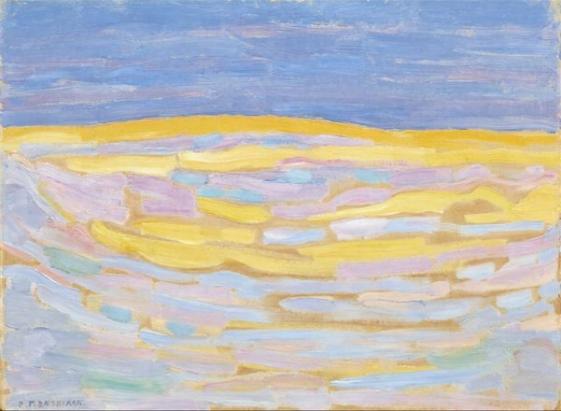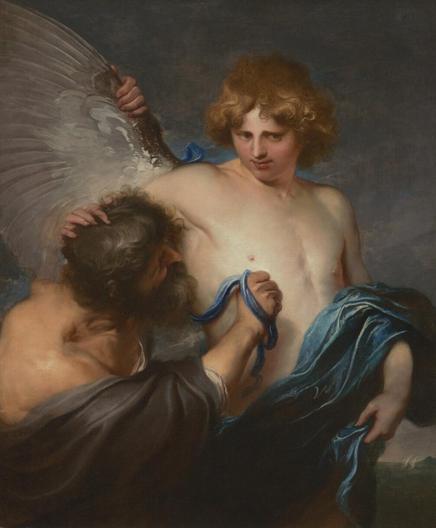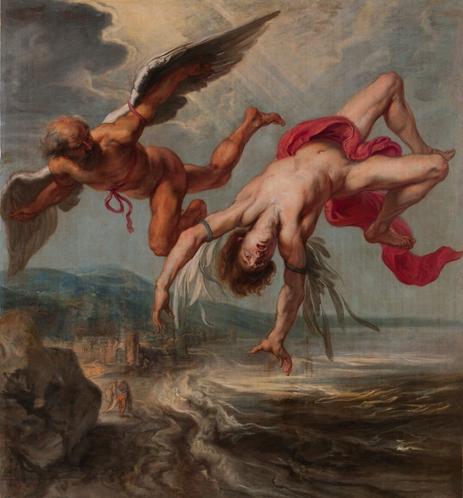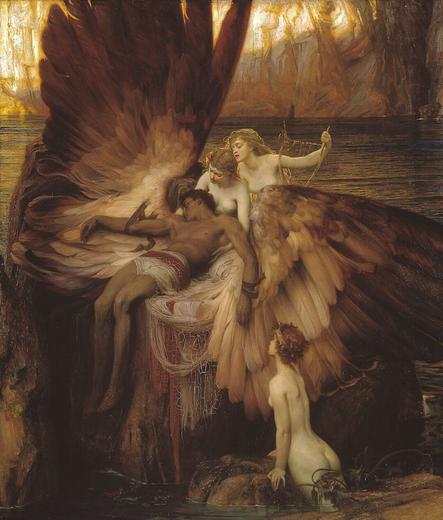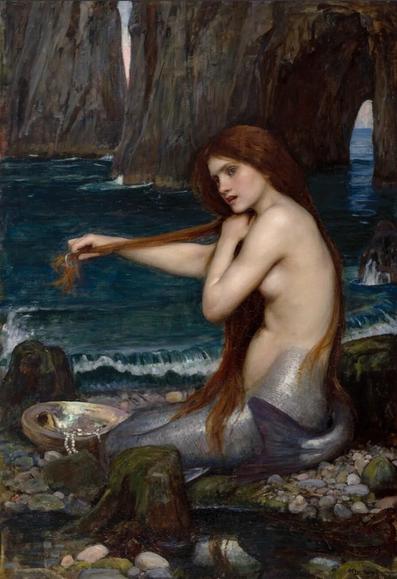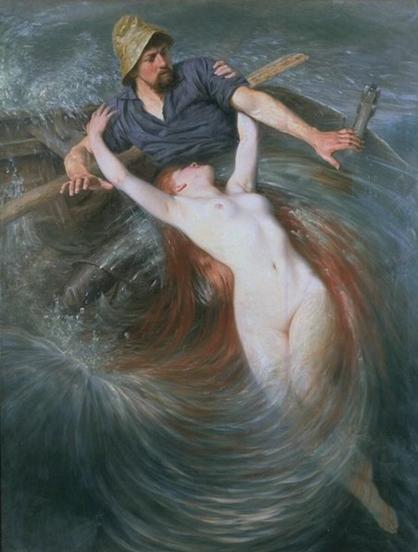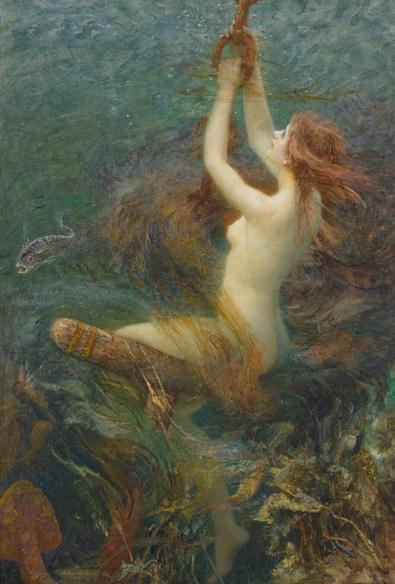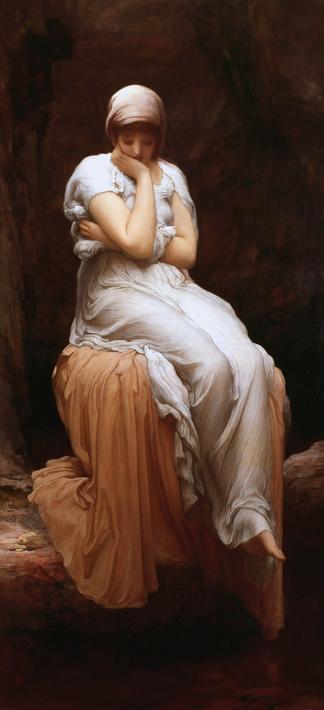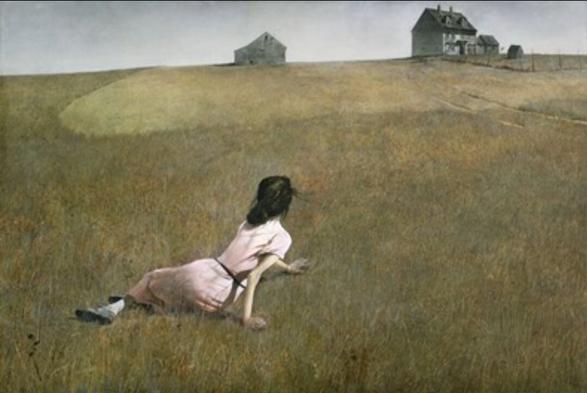Dante Gabriel Rossetti (English, 1828-1882)
Proserpine
1874
Oil on canvas (125,1 x 61 cm)
Tate
Although Rossetti inscribed the date 1874 on the picture, he worked for seven years on eight separate canvases before he finished with it. His Proserpine, like his model Jane Morris, is an exquisitely beautiful woman, with delicate facial features, slender hands, and flawlessly pale skin set off by her thick raven hair. Rossetti painted it at a time when his mental health was extremely precarious and his love for Jane Morris was at its most obsessive.
Unable to decide as a young man whether to concentrate on painting or poetry, his work is infused with his poetic imagination and an individual interpretation of literary sources. His accompanying sonnet to this work is a poem of longing: "And still some heart unto some soul doth pine," carrying an inescapable allusion to his yearning to seduce Jane from her unhappy marriage with William Morris. Proserpine had been imprisoned in Pluto's underground realm for tasting the forbidden pomegranate. Jane, trapped by convention, was also tasting forbidden fruit. There is a deeper meaning in the painting as Rossetti stayed with Jane at Kelmscott Manor during the summer months each year and in winter she returned to stay with William Morris, thus paralleling Proserpine's freedom during summer.
In Roman mythology, Proserpine, daughter of Jupiter and Ceres, was carried off to the Underworld (Hades) by Pluto, who married her despite her love for Adonis. When Ceres begged Jupiter to return her daughter to Earth, he agreed, on condition that Proserpine had not eaten any fruits in Hades. As Proserpine had eaten six pomegranate seeds, it was decreed that she should remain in Hades for six months of the year and be allowed on Earth for the other six.
#Rossetti #Proserpine #Pre-Raphaelites #art
Everyday a triptych
John Everett Millais (English, 1829-1896)
Ophelia
1851-1852
Oil on canvas (76 x 112 cm)
Tate
The painting depicts Ophelia singing while floating in a river just before she drowns. The scene is described in Hamlet in a speech by Queen Gertrude.
The episode depicted is not usually seen onstage, as in Shakespeare's text it exists only in Gertrude's description. Out of her mind with grief, Ophelia has been making garlands of wildflowers. She climbs into a willow tree overhanging a brook to dangle some from its branches, and a bough breaks beneath her. She lies in the water singing songs, as if unaware of her danger ("incapable of her own distress"). Her clothes, trapping air, have allowed her to temporarily stay afloat ("Her clothes spread wide, / And, mermaid-like, awhile they bore her up."). But eventually, "her garments, heavy with their drink, / Pull'd the poor wretch from her melodious lay" down "to muddy death".
Ophelia's death has been praised as one of the most poetically written death scenes in literature.
Ophelia was modelled by artist and muse Elizabeth Siddall, then 22 years old. Millais had Siddall lie fully clothed in a full bathtub in his studio in London. As it was now winter, he placed oil lamps under the tub to warm the water, but was so intent on his work that he allowed them to go out. As a result, Siddall caught a severe cold, and her father later sent Millais a letter demanding £50 for medical expenses. According to Millais's son, he eventually accepted a lower sum.
#Millais #Ophelia #Tate #art #Pre-Raphaelites
Ophelia
1851-1852
Oil on canvas (76 x 112 cm)
Tate
The painting depicts Ophelia singing while floating in a river just before she drowns. The scene is described in Hamlet in a speech by Queen Gertrude.
The episode depicted is not usually seen onstage, as in Shakespeare's text it exists only in Gertrude's description. Out of her mind with grief, Ophelia has been making garlands of wildflowers. She climbs into a willow tree overhanging a brook to dangle some from its branches, and a bough breaks beneath her. She lies in the water singing songs, as if unaware of her danger ("incapable of her own distress"). Her clothes, trapping air, have allowed her to temporarily stay afloat ("Her clothes spread wide, / And, mermaid-like, awhile they bore her up."). But eventually, "her garments, heavy with their drink, / Pull'd the poor wretch from her melodious lay" down "to muddy death".
Ophelia's death has been praised as one of the most poetically written death scenes in literature.
Ophelia was modelled by artist and muse Elizabeth Siddall, then 22 years old. Millais had Siddall lie fully clothed in a full bathtub in his studio in London. As it was now winter, he placed oil lamps under the tub to warm the water, but was so intent on his work that he allowed them to go out. As a result, Siddall caught a severe cold, and her father later sent Millais a letter demanding £50 for medical expenses. According to Millais's son, he eventually accepted a lower sum.
#Millais #Ophelia #Tate #art #Pre-Raphaelites
John William Waterhouse (English, 1849-1917)
Psyche Opening the Golden Box
1903
Oil on canvas (117 x 74 cm)
Private collection
Psyche, the daughter of a king, incurred the wrath of Venus who eyed her as a rival. She instructed Cupid, her son, to infect Psyche’s heart with love for an outcast, but Cupid fell in love with her and visited her every night in her chamber. Fearing Psyche would be unable to resist his beauty, he remained invisible and warned her not to steal a look at him. One night, overcome with curiosity and goaded by her wicked sisters, Psyche took a lamp and shone it over Cupid as he lay asleep. She was so startled by his beauty that she spilled a drop of hot oil on his shoulder and woke the god from his slumber. Cupid was filled with anger at her disobedience and departed at once, leaving Psyche sad and deeply regretful. She roamed the earth in search of her lover, facing obstacles thrown in her way by Venus.
One of Psyche’s tasks is to retrieve a golden box from Persephone, the queen of the underworld, and deliver it to Venus. Psyche is warned not to open the box, but her curiosity overwhelms her. Upon opening it, she finds not beauty, as expected, but a deadly sleep that renders her unconscious.
When Cupid finds Psyche, he draws the sleep from her face and replaces it in the box. He lifts her into the air, and takes her to present the box to Venus.
He then takes his case to Jupiter, who gives his consent in return for Cupid's future help whenever a choice maiden catches his eye. Jupiter gives Psyche ambrosia, the drink of immortality, so the couple can be united in marriage as equals.
Waterhouse’s painting illustrates this moment of forbidden curiosity, highlighting both Psyche’s human frailty and her enduring grace.
#Waterhouse #art #Psyche #Cupid #Pre-Raphaelites
Psyche Opening the Golden Box
1903
Oil on canvas (117 x 74 cm)
Private collection
Psyche, the daughter of a king, incurred the wrath of Venus who eyed her as a rival. She instructed Cupid, her son, to infect Psyche’s heart with love for an outcast, but Cupid fell in love with her and visited her every night in her chamber. Fearing Psyche would be unable to resist his beauty, he remained invisible and warned her not to steal a look at him. One night, overcome with curiosity and goaded by her wicked sisters, Psyche took a lamp and shone it over Cupid as he lay asleep. She was so startled by his beauty that she spilled a drop of hot oil on his shoulder and woke the god from his slumber. Cupid was filled with anger at her disobedience and departed at once, leaving Psyche sad and deeply regretful. She roamed the earth in search of her lover, facing obstacles thrown in her way by Venus.
One of Psyche’s tasks is to retrieve a golden box from Persephone, the queen of the underworld, and deliver it to Venus. Psyche is warned not to open the box, but her curiosity overwhelms her. Upon opening it, she finds not beauty, as expected, but a deadly sleep that renders her unconscious.
When Cupid finds Psyche, he draws the sleep from her face and replaces it in the box. He lifts her into the air, and takes her to present the box to Venus.
He then takes his case to Jupiter, who gives his consent in return for Cupid's future help whenever a choice maiden catches his eye. Jupiter gives Psyche ambrosia, the drink of immortality, so the couple can be united in marriage as equals.
Waterhouse’s painting illustrates this moment of forbidden curiosity, highlighting both Psyche’s human frailty and her enduring grace.
#Waterhouse #art #Psyche #Cupid #Pre-Raphaelites
Jules Dupré (French, 1811-1889)
Sunset on the Coast
Ca. 1870-1875
Oil on canvas (74,1 x 60,8 cm)
Walters Art Museum
Dupré concentrated on marine painting during the last twenty years of his life. He acquired a house at Cayeux in 1865, returning annually. These late paintings are characterized by low horizons, intense colors, and thick, impasto effects. Here, the golden orb of the sun silhouettes the fishing boats and is dramatically reflected in the clouds above.
#Dupré #art
Sunset on the Coast
Ca. 1870-1875
Oil on canvas (74,1 x 60,8 cm)
Walters Art Museum
Dupré concentrated on marine painting during the last twenty years of his life. He acquired a house at Cayeux in 1865, returning annually. These late paintings are characterized by low horizons, intense colors, and thick, impasto effects. Here, the golden orb of the sun silhouettes the fishing boats and is dramatically reflected in the clouds above.
#Dupré #art
William Turner (English, 1775-1851)
The Fighting Temeraire tugged to her last berth to be broken up, 1838
1839
Oil on canvas (90,7 x 121,6 cm)
National Gallery
The painting depicts the 98-gun HMS Temeraire, one of the last second-rate ships of the line to have played a role in the Battle of Trafalgar, being towed up the Thames by a paddle-wheel steam tug in 1838, towards its final berth in Rotherhithe to be broken up for scrap.
The composition of this painting is unusual in that the most significant object, the old warship, is positioned well to the left of the painting, where it rises in stately splendour and almost ghostlike colours against a triangle of blue sky and rising mist that throws it into relief. The beauty of the old ship contrasts with the dirty blackened tugboat with its tall smokestack, which churns the otherwise still surface of the river.
The blue triangle frames a second triangle of masted ships, which decrease in size as they become more distant. The Temeraire and tugboat have passed a small river craft with its gaff rigged sail barely catching a breeze. Beyond this a square-rigger drifts, with all its sail extended. Another small craft shows as a patch of white farther down the river. In the far distance, beyond a second tugboat which makes its way towards them, a three-masted ship rides at anchor. The becalmed vessels show the obsolescence of sail.
On the opposite side of the painting to Temeraire, the same distance from the frame as the ship's main mast, the Sun sets above the estuary, its rays extending into the clouds above it, and across the surface of the water. The red of the clouds is reflected in the river, repeating the colour of the smoke from the tugboat. The sun setting symbolises the end of an era; one where sail has been overtaken by steam.
#Turner #NationalGallery #art
The Fighting Temeraire tugged to her last berth to be broken up, 1838
1839
Oil on canvas (90,7 x 121,6 cm)
National Gallery
The painting depicts the 98-gun HMS Temeraire, one of the last second-rate ships of the line to have played a role in the Battle of Trafalgar, being towed up the Thames by a paddle-wheel steam tug in 1838, towards its final berth in Rotherhithe to be broken up for scrap.
The composition of this painting is unusual in that the most significant object, the old warship, is positioned well to the left of the painting, where it rises in stately splendour and almost ghostlike colours against a triangle of blue sky and rising mist that throws it into relief. The beauty of the old ship contrasts with the dirty blackened tugboat with its tall smokestack, which churns the otherwise still surface of the river.
The blue triangle frames a second triangle of masted ships, which decrease in size as they become more distant. The Temeraire and tugboat have passed a small river craft with its gaff rigged sail barely catching a breeze. Beyond this a square-rigger drifts, with all its sail extended. Another small craft shows as a patch of white farther down the river. In the far distance, beyond a second tugboat which makes its way towards them, a three-masted ship rides at anchor. The becalmed vessels show the obsolescence of sail.
On the opposite side of the painting to Temeraire, the same distance from the frame as the ship's main mast, the Sun sets above the estuary, its rays extending into the clouds above it, and across the surface of the water. The red of the clouds is reflected in the river, repeating the colour of the smoke from the tugboat. The sun setting symbolises the end of an era; one where sail has been overtaken by steam.
#Turner #NationalGallery #art
Claude Monet (French, 1840-1926)
Sailing Boat, Evening Effect
1885
Oil on canvas (54 x 65 cm)
Musée Marmottan Monet
Guy De Maupassant wrote about his friend: Last year, in this country, I often followed Claude Monet in search of impressions. He was not a painter, in truth, but a hunter. He would go, followed by children carrying his canvases, five or six canvases depicting the same motif, at different times of day and with different light effects. He would take them up and put them down again in turn, according to the changes in the sky. And the painter, in front of his subject, would stand waiting for the sun and the shadows, fixing with a few brushstrokes the ray that appeared or the cloud that passed. And scornful of the false and the untimely, he would lay them on the canvas with speed I have seen him thus catch a gleam of light on a white rock, and record it with a stream of yellow brushstrokes that, strangely enough, made the sudden and fleeting effect of that rapid and elusive glow. Another time he took in full force a downpour of water that had fallen on the sea and threw it quickly onto the canvas. And it was precisely rain that he had managed to paint, nothing but of the rain that veiled the waves, rocks and sky, barely distinguishable under that downpour.
Hunter of subjects also thanks to a discovery of the time that marks a fundamental moment for painting: the invention of the tube of color that allowed artists to leave the closed studio, stop using pigments and paint en plein air, bringing along the easel to be placed freely.
#Monet #art #oilpaint #impressionism
Sailing Boat, Evening Effect
1885
Oil on canvas (54 x 65 cm)
Musée Marmottan Monet
Guy De Maupassant wrote about his friend: Last year, in this country, I often followed Claude Monet in search of impressions. He was not a painter, in truth, but a hunter. He would go, followed by children carrying his canvases, five or six canvases depicting the same motif, at different times of day and with different light effects. He would take them up and put them down again in turn, according to the changes in the sky. And the painter, in front of his subject, would stand waiting for the sun and the shadows, fixing with a few brushstrokes the ray that appeared or the cloud that passed. And scornful of the false and the untimely, he would lay them on the canvas with speed I have seen him thus catch a gleam of light on a white rock, and record it with a stream of yellow brushstrokes that, strangely enough, made the sudden and fleeting effect of that rapid and elusive glow. Another time he took in full force a downpour of water that had fallen on the sea and threw it quickly onto the canvas. And it was precisely rain that he had managed to paint, nothing but of the rain that veiled the waves, rocks and sky, barely distinguishable under that downpour.
Hunter of subjects also thanks to a discovery of the time that marks a fundamental moment for painting: the invention of the tube of color that allowed artists to leave the closed studio, stop using pigments and paint en plein air, bringing along the easel to be placed freely.
#Monet #art #oilpaint #impressionism
Artist unknown
Flora (or Persephone or the allegory of Spring)
1st century AD
Fresco (38 x 32 cm)
National Archaeological Museum of Naples
This fresco was found in Villa Arianna in Stabiae. Stabiae was an ancient Roman city, or rather a string of luxury villas stretching along the coast, located on the western side of Italy, in the modern-day region of Campania. It was well known for its luxurious villas and rich maritime trade. The city was destroyed by the eruption of Mount Vesuvius in 79 AD, along with the nearby city of Pompeii. The well-preserved remains of Stabiae, including frescoes and mosaics, offer a unique glimpse into the daily life and culture of ancient Rome. Among the many treasures discovered in Villa Arianna is the fresco of Flora, exhibited today in the National Archaeological Museum of Naples. It is a 38×32 cm fresco, created for the triclinium area of the Villa. The fresco depicts the goddess Flora, the Roman goddess of flowers and spring, surrounded by a variety of plants and flowers. In vibrant colors, intricate details, and naturalistic depictions of plants and flowers, the lovely Flora, a young girl shown with her back to us, delicately gathering spring flowers. Barefoot with a light step, her veil and the hem of her dress floating in the air, Flora turns suddenly to the side to pick a spring from a thin shrub with white flowers. Shown in a relaxed and carefree manner, the goddess is thought to reflect the changing cultural attitudes of the time, the increasing wealth and luxury of the Roman Empire, and may suggest a greater appreciation for the beauty and abundance of nature in ancient Campania.
#Pompeii #Stabiae #fresco #art #Rome
Flora (or Persephone or the allegory of Spring)
1st century AD
Fresco (38 x 32 cm)
National Archaeological Museum of Naples
This fresco was found in Villa Arianna in Stabiae. Stabiae was an ancient Roman city, or rather a string of luxury villas stretching along the coast, located on the western side of Italy, in the modern-day region of Campania. It was well known for its luxurious villas and rich maritime trade. The city was destroyed by the eruption of Mount Vesuvius in 79 AD, along with the nearby city of Pompeii. The well-preserved remains of Stabiae, including frescoes and mosaics, offer a unique glimpse into the daily life and culture of ancient Rome. Among the many treasures discovered in Villa Arianna is the fresco of Flora, exhibited today in the National Archaeological Museum of Naples. It is a 38×32 cm fresco, created for the triclinium area of the Villa. The fresco depicts the goddess Flora, the Roman goddess of flowers and spring, surrounded by a variety of plants and flowers. In vibrant colors, intricate details, and naturalistic depictions of plants and flowers, the lovely Flora, a young girl shown with her back to us, delicately gathering spring flowers. Barefoot with a light step, her veil and the hem of her dress floating in the air, Flora turns suddenly to the side to pick a spring from a thin shrub with white flowers. Shown in a relaxed and carefree manner, the goddess is thought to reflect the changing cultural attitudes of the time, the increasing wealth and luxury of the Roman Empire, and may suggest a greater appreciation for the beauty and abundance of nature in ancient Campania.
#Pompeii #Stabiae #fresco #art #Rome
Giotto (Italian, 1266-1337)
The Last Judgment
1306
Fresco
Cappella Scrovegni, Padua
This grand fresco covers most of the chapel's counterfaçade. A double white line divides it into two registers, one above for Christ in Heaven and one below for the actual judgment of the saved and damned souls. In the center of the upper register Christ sits on a rainbow in a mandorla. The rainbow is common in medieval images of the Last Judgment and also in at least one image of Daniel's vision of the Son of Man. It alludes to Revelation 4:3, "there was a rainbow round about the throne."
Four creatures, representing the four evangelists, are at Christ's thighs in Giotto's image: St. John's eagle and St. Mark's lion on the right, and on the left the ox of St. Luke and an odd construction that must represent St. Matthew. The green area beneath Christ's feet may be an allusion to the "sea of glass" in the text. Four of the angels that surround the mandorla blow trumpets, a sign of the Last Judgment mentioned again and again in the New Testament.
The twelve Apostles sit left and right of the mandorla, above them multitudes of saints guarded by angels with weapons and military garb. Above the multitudes, two angels reveal the doors to Heaven by unwinding the sky as if it were a curtain or veil. "Revelation" literally means the removal of a veil.
On the left side of the lower register the dead rise from their tombs and are conducted by angels to the judgment. Among them are a Franciscan and a Dominican standing together. Above them are those who have been saved, each bearing a halo. Front and center inthat group is Moses, identified by his horns. Perhaps the man standing with him is Aaron. On the right side of the lower register Satan and his minions torture the damned souls, often in ways sexually perverse.
Christ's cross stands between the two halves of the lower register, held up by a mysterious figure most of whose body is hidden behind the wood. He seems to have a halo.
#Giotto
The Last Judgment
1306
Fresco
Cappella Scrovegni, Padua
This grand fresco covers most of the chapel's counterfaçade. A double white line divides it into two registers, one above for Christ in Heaven and one below for the actual judgment of the saved and damned souls. In the center of the upper register Christ sits on a rainbow in a mandorla. The rainbow is common in medieval images of the Last Judgment and also in at least one image of Daniel's vision of the Son of Man. It alludes to Revelation 4:3, "there was a rainbow round about the throne."
Four creatures, representing the four evangelists, are at Christ's thighs in Giotto's image: St. John's eagle and St. Mark's lion on the right, and on the left the ox of St. Luke and an odd construction that must represent St. Matthew. The green area beneath Christ's feet may be an allusion to the "sea of glass" in the text. Four of the angels that surround the mandorla blow trumpets, a sign of the Last Judgment mentioned again and again in the New Testament.
The twelve Apostles sit left and right of the mandorla, above them multitudes of saints guarded by angels with weapons and military garb. Above the multitudes, two angels reveal the doors to Heaven by unwinding the sky as if it were a curtain or veil. "Revelation" literally means the removal of a veil.
On the left side of the lower register the dead rise from their tombs and are conducted by angels to the judgment. Among them are a Franciscan and a Dominican standing together. Above them are those who have been saved, each bearing a halo. Front and center inthat group is Moses, identified by his horns. Perhaps the man standing with him is Aaron. On the right side of the lower register Satan and his minions torture the damned souls, often in ways sexually perverse.
Christ's cross stands between the two halves of the lower register, held up by a mysterious figure most of whose body is hidden behind the wood. He seems to have a halo.
#Giotto
Pinturicchio, (Italian, 1454-1513)
Glory of St. Bernardino
1484-1486
Fresco
Bufalini Chapel, Santa Maria in Aracoeli
The frescoes in this chapel occupy three walls, and portray the life and miracles of Bernardino of Siena, a Franciscan Friar recently canonized.
The central wall is decorated with the Glory of St. Bernardino, on two levels. The lower section portrays Bernardino on a rock, with open arms, surmounted by two angels crowning him. He is flanked by the saints Louis of Toulouse and Antony of Padua, while in the background is a landscape inspired by those of Umbria. The upper sector depicts a blessing Christ within an almond, with angels and musicians.
Bernardino holds a book on which is written PATER MANIFESTAVI NOMEN TVVM OMNIBVS ("Father, I have shown your name to everyone"), the words the friars were chanting as Bernardino passed away on Ascension eve, 1444.
#Pinturicchio #fresco #Rome #art
Glory of St. Bernardino
1484-1486
Fresco
Bufalini Chapel, Santa Maria in Aracoeli
The frescoes in this chapel occupy three walls, and portray the life and miracles of Bernardino of Siena, a Franciscan Friar recently canonized.
The central wall is decorated with the Glory of St. Bernardino, on two levels. The lower section portrays Bernardino on a rock, with open arms, surmounted by two angels crowning him. He is flanked by the saints Louis of Toulouse and Antony of Padua, while in the background is a landscape inspired by those of Umbria. The upper sector depicts a blessing Christ within an almond, with angels and musicians.
Bernardino holds a book on which is written PATER MANIFESTAVI NOMEN TVVM OMNIBVS ("Father, I have shown your name to everyone"), the words the friars were chanting as Bernardino passed away on Ascension eve, 1444.
#Pinturicchio #fresco #Rome #art
Piet Mondriaan (Dutch, 1872-1944)
Dunes near Domburg
1910
Oil on canvas (65,5 x 96 cm)
Kunstmuseum Den Haag
Piet Mondriaan is one of the founders of abstract art. In his oeuvre, the route he takes from realistic figuration to radical abstraction can be easily followed. His geometric-abstract work with the characteristic horizontal and vertical lines and primary color planes is world famous. However, Mondriaan began his career with realistic landscape paintings. At the beginning of the twentieth century, the landscapes became more idiosyncratic in line and color. 'Dunes near Domburg' was already described in Mondriaan's time as 'the sensation one experiences when being in such a dune pan, somewhat unsafe and yet together with the wide sky'.
'Dunes near Domburg' shows a dune pan near Domburg as they were depicted on postcards between 1909 and 1913, for sale to tourists who visited Walcheren. Mondrian completely takes this representation to his own taste.
Just as in The Red Cloud (c. 1907), Mondrian uses a bowl-shaped image closure in the foreground to give the flat composition space. He then translates almost all the colors into bright, blue-purple nuances, which reflect something of looking into the light on a sun-drenched day. Mondrian then captures the sparkle of the sunlight along the contours of the dune with yellow and white. Later, Mondrian emphasizes that this specific use of color and these coarser forms go hand in hand and cannot be seen separately.
#Mondriaan #KunstmuseumDenHaag #art
Dunes near Domburg
1910
Oil on canvas (65,5 x 96 cm)
Kunstmuseum Den Haag
Piet Mondriaan is one of the founders of abstract art. In his oeuvre, the route he takes from realistic figuration to radical abstraction can be easily followed. His geometric-abstract work with the characteristic horizontal and vertical lines and primary color planes is world famous. However, Mondriaan began his career with realistic landscape paintings. At the beginning of the twentieth century, the landscapes became more idiosyncratic in line and color. 'Dunes near Domburg' was already described in Mondriaan's time as 'the sensation one experiences when being in such a dune pan, somewhat unsafe and yet together with the wide sky'.
'Dunes near Domburg' shows a dune pan near Domburg as they were depicted on postcards between 1909 and 1913, for sale to tourists who visited Walcheren. Mondrian completely takes this representation to his own taste.
Just as in The Red Cloud (c. 1907), Mondrian uses a bowl-shaped image closure in the foreground to give the flat composition space. He then translates almost all the colors into bright, blue-purple nuances, which reflect something of looking into the light on a sun-drenched day. Mondrian then captures the sparkle of the sunlight along the contours of the dune with yellow and white. Later, Mondrian emphasizes that this specific use of color and these coarser forms go hand in hand and cannot be seen separately.
#Mondriaan #KunstmuseumDenHaag #art
Piet Mondriaan (Dutch, 1872-1944)
Dune IV
1909
Oil on cardboard (33 x 46 cm)
Kunstmuseum Den Haag
#Mondriaan #KunstmuseumDenHaag #art
Dune IV
1909
Oil on cardboard (33 x 46 cm)
Kunstmuseum Den Haag
#Mondriaan #KunstmuseumDenHaag #art
Piet Mondriaan (Dutch, 1872-1944)
Dune I
1909
Oil on cardboard (30 x 40 cm)
Kunstmuseum Den Haag
#Mondriaan # KunstmuseumDenHaag #art
Dune I
1909
Oil on cardboard (30 x 40 cm)
Kunstmuseum Den Haag
#Mondriaan # KunstmuseumDenHaag #art
Anthony van Dyck (Belgian, 1599-1641)
Icarus and Daedalus
Ca. 1618
Oil on canvas (112,3 x 93 cm)
Museum of Fine Arts
In Greek mythology, Icarus was the son of the master craftsman Daedalus, the architect of the labyrinth of Crete. After Theseus, king of Athens and enemy of King Minos, escaped from the labyrinth, Minos suspected that Icarus and Daedalus had revealed the labyrinth's secrets and imprisoned them. Icarus and Daedalus escaped using wings Daedalus constructed from birds’ molted feathers, threads from blankets, the leather straps from their sandals, and beeswax. Before escaping, Daedalus warned Icarus not to fly too low or the water would soak the feathers and not to fly too close to the sun or the heat would melt the wax. Icarus ignored Daedalus's instructions not to fly too close to the sun, causing the beeswax in his wings to melt. Icarus fell from the sky, plunged into the sea, and drowned.
In this painting Van Dyck depicts himself as Icarus, with an expression that does not seem as if he’s following his father’s advice. He’s not looking at his father. As if Icarus is in the process of making the decision to disobey his father, to do what he wants to do.
This is a painting of a Greek myth, but also illustrative of the artist’s own life, of his own relationship with his father, or an important father figure in his life. Van Dyck has, in a sense, two fathers. He’s got a biological father, who he separated from, in a legal sense, not long before this painting was made. He also is separating himself from his teacher, Peter Paul Rubens, the great Flemish Baroque painter who had taught him much and was the major artistic figure in Antwerp and across Europe in the early 17th century.
Van Dyck is showing us that he is thinking about himself in his role as an artist, and what he can do, and where he wants to go as an artist. But not just thinking about it, but recording those thoughts in the form of a large-scale painting.
#VanDyck #Icarus #Daedalus #art
Icarus and Daedalus
Ca. 1618
Oil on canvas (112,3 x 93 cm)
Museum of Fine Arts
In Greek mythology, Icarus was the son of the master craftsman Daedalus, the architect of the labyrinth of Crete. After Theseus, king of Athens and enemy of King Minos, escaped from the labyrinth, Minos suspected that Icarus and Daedalus had revealed the labyrinth's secrets and imprisoned them. Icarus and Daedalus escaped using wings Daedalus constructed from birds’ molted feathers, threads from blankets, the leather straps from their sandals, and beeswax. Before escaping, Daedalus warned Icarus not to fly too low or the water would soak the feathers and not to fly too close to the sun or the heat would melt the wax. Icarus ignored Daedalus's instructions not to fly too close to the sun, causing the beeswax in his wings to melt. Icarus fell from the sky, plunged into the sea, and drowned.
In this painting Van Dyck depicts himself as Icarus, with an expression that does not seem as if he’s following his father’s advice. He’s not looking at his father. As if Icarus is in the process of making the decision to disobey his father, to do what he wants to do.
This is a painting of a Greek myth, but also illustrative of the artist’s own life, of his own relationship with his father, or an important father figure in his life. Van Dyck has, in a sense, two fathers. He’s got a biological father, who he separated from, in a legal sense, not long before this painting was made. He also is separating himself from his teacher, Peter Paul Rubens, the great Flemish Baroque painter who had taught him much and was the major artistic figure in Antwerp and across Europe in the early 17th century.
Van Dyck is showing us that he is thinking about himself in his role as an artist, and what he can do, and where he wants to go as an artist. But not just thinking about it, but recording those thoughts in the form of a large-scale painting.
#VanDyck #Icarus #Daedalus #art
Jacob Peter Gowy (Belgian, ca. 1615-1661)
The Fall of Icarus
Ca. 1635-1637
Oil on canvas (195 x 180 cm)
Museo del Prado
Jacob Peter Gouwy or Jacob Peter Gowy was a Flemish Baroque painter of history paintings and portraits. He collaborated with Peter Paul Rubens in the mid-1630s. In 1636 Rubens received a commission from the Spanish king Philip IV of Spain to create a series of mythological paintings to decorate the Torre de la Parada, a hunting lodge of the king near Madrid. The mythological scenes depicted in the series were largely based on the Metamorphoses of Ovid. Rubens realized this important commission with the assistance of a large number of Antwerp painters who worked after Rubens' designs. Gouwy was also involved in this project as a collaborator. Two of the canvases which Gouwy created after designs by Rubens, one representing The Fall of Icarus and the other Hippomenes and Atalanta, are in the collection of the Museo del Prado in Madrid. A comparison with Rubens' original designs shows that the artist only made minor modifications to these designs.
#Gowy #Icarus #art
The Fall of Icarus
Ca. 1635-1637
Oil on canvas (195 x 180 cm)
Museo del Prado
Jacob Peter Gouwy or Jacob Peter Gowy was a Flemish Baroque painter of history paintings and portraits. He collaborated with Peter Paul Rubens in the mid-1630s. In 1636 Rubens received a commission from the Spanish king Philip IV of Spain to create a series of mythological paintings to decorate the Torre de la Parada, a hunting lodge of the king near Madrid. The mythological scenes depicted in the series were largely based on the Metamorphoses of Ovid. Rubens realized this important commission with the assistance of a large number of Antwerp painters who worked after Rubens' designs. Gouwy was also involved in this project as a collaborator. Two of the canvases which Gouwy created after designs by Rubens, one representing The Fall of Icarus and the other Hippomenes and Atalanta, are in the collection of the Museo del Prado in Madrid. A comparison with Rubens' original designs shows that the artist only made minor modifications to these designs.
#Gowy #Icarus #art
Herbert James Draper (English, 1863-1920)
The Lament for Icarus
1898
Oil on canvas (180 x 150 cm)
Tate
Draper applied liquid light effects without abandoning form and used mainly warm colours. The tanned skin of Icarus refers to his close approach to the Sun before falling down. The rays of the setting sun on distant cliffs emphasize the transience of time. Moralizing, sentimental, and sensual, The Lament for Icarus ultimately became a well-composed image of epic failure. However, somewhat surprising, Icarus has his wings fully intact, contrary to the myth where the wax melted and Icarus fell flapping his bare arms.
#Draper #Icarus #art
The Lament for Icarus
1898
Oil on canvas (180 x 150 cm)
Tate
Draper applied liquid light effects without abandoning form and used mainly warm colours. The tanned skin of Icarus refers to his close approach to the Sun before falling down. The rays of the setting sun on distant cliffs emphasize the transience of time. Moralizing, sentimental, and sensual, The Lament for Icarus ultimately became a well-composed image of epic failure. However, somewhat surprising, Icarus has his wings fully intact, contrary to the myth where the wax melted and Icarus fell flapping his bare arms.
#Draper #Icarus #art
John William Waterhouse (English, 1849-1917)
A Mermaid
1900
Oil on canvas (96,5 x 66,6 cm)
Royal Academy of Arts
It is possible that Waterhouse's painting of A Mermaid was inspired by Alfred Lord Tennyson's poem The Mermaid (1830) which includes the lines:
Who would be
A mermaid fair,
Singing alone,
Combing her hair
Tennyson's poem goes on to describe the mermaid seeking and finding love among the mermen:
Of the bold merry mermen under the sea.
They would sue me, and woo me, and flatter me,
In the purple twilights under the sea;
But the king of them all would carry me,
Woo me, and win me, and marry me.
However Waterhouse was also interested in the darker mythology of the mermaid as an enchantress. Mermaids traditionally were sirens who lured sailors to their death through their captivating song. They were also tragic figures as mermaids could not survive in the human world which they yearned for and men could not exist in their watery realm, so any relationship was doomed. In Waterhouse's painting no sailors are depicted so that despite being a 'siren' the mermaid is shown as an alluring rather lonely figure, albeit with a fish tail. The atmosphere evoked is one of gentle melancholy as the mermaid sits alone in an isolated inlet, dreamily combing out her long hair with her lips parted in song. Beside her is a shell filled with pearls, which some believed to be formed from the tears of dead sailors.
#Waterhouse #RA #RoyalAcademy #art #Mermaid #Siren
A Mermaid
1900
Oil on canvas (96,5 x 66,6 cm)
Royal Academy of Arts
It is possible that Waterhouse's painting of A Mermaid was inspired by Alfred Lord Tennyson's poem The Mermaid (1830) which includes the lines:
Who would be
A mermaid fair,
Singing alone,
Combing her hair
Tennyson's poem goes on to describe the mermaid seeking and finding love among the mermen:
Of the bold merry mermen under the sea.
They would sue me, and woo me, and flatter me,
In the purple twilights under the sea;
But the king of them all would carry me,
Woo me, and win me, and marry me.
However Waterhouse was also interested in the darker mythology of the mermaid as an enchantress. Mermaids traditionally were sirens who lured sailors to their death through their captivating song. They were also tragic figures as mermaids could not survive in the human world which they yearned for and men could not exist in their watery realm, so any relationship was doomed. In Waterhouse's painting no sailors are depicted so that despite being a 'siren' the mermaid is shown as an alluring rather lonely figure, albeit with a fish tail. The atmosphere evoked is one of gentle melancholy as the mermaid sits alone in an isolated inlet, dreamily combing out her long hair with her lips parted in song. Beside her is a shell filled with pearls, which some believed to be formed from the tears of dead sailors.
#Waterhouse #RA #RoyalAcademy #art #Mermaid #Siren
Knut Ekvall (Swedish, 1843-1912)
The Fisherman and The Siren
1880s
Oil on canvas (195 x 150 cm)
Private collection
According to Greek myths, sirens were powerful and erotic creatures, and many unsuspecting sailors would fall prey to their seductive beauty. The common belief was that they would devour sailors after their ships would crash into the rocks, as most men couldn't resist the temptation of their sweet melodies and angelic faces.
#Ekvall #Sirens #art
The Fisherman and The Siren
1880s
Oil on canvas (195 x 150 cm)
Private collection
According to Greek myths, sirens were powerful and erotic creatures, and many unsuspecting sailors would fall prey to their seductive beauty. The common belief was that they would devour sailors after their ships would crash into the rocks, as most men couldn't resist the temptation of their sweet melodies and angelic faces.
#Ekvall #Sirens #art
Arthur Hopkins (English, 1847-1930)
A Fantasy of the Deep
1903
Watercolour with bodycolour (97 x 66 cm)
Private collection
Hopkins was born on 30 December 1847 in London (and died there on 10 September 1930). Arthur was the younger brother of the poet Gerard Manley Hopkins, and was educated at Lancing College, Sussex. He entered the RA Schools in 1872, and began exhibiting at main London galleries from that time. In 1879 he exhibited a Newlyn title at the RA, placing his presence in West Cornwall amongst the earliest of the artists. As an illustrator he contributed to The Graphic, Punch and Illustrated London News, working on the serial version of Hardy's Return of the Native, among other things.
#Hopkins #Siren #art
A Fantasy of the Deep
1903
Watercolour with bodycolour (97 x 66 cm)
Private collection
Hopkins was born on 30 December 1847 in London (and died there on 10 September 1930). Arthur was the younger brother of the poet Gerard Manley Hopkins, and was educated at Lancing College, Sussex. He entered the RA Schools in 1872, and began exhibiting at main London galleries from that time. In 1879 he exhibited a Newlyn title at the RA, placing his presence in West Cornwall amongst the earliest of the artists. As an illustrator he contributed to The Graphic, Punch and Illustrated London News, working on the serial version of Hardy's Return of the Native, among other things.
#Hopkins #Siren #art
Frederic Leighton (English, 1830-1896)
Solitude
Ca. 1890
Oil on canvas (182,8 x 91,4)
Maryhill Museum of Art
Leighton's paintings were enormously popular and expensive during his lifetime, but for some reason, fell out of favor in the early 20th century. Generally, his work illustrates biblical, classical, and historical subject matters but this painting is more on the metaphorical side as he invokes the feeling of solitude and isolation. Leighton explains his attempt to do this with the location of this painting. He describes it to his sister as “the vehemence of winter has scooped and worn pools so deep that . . . you come at last to absolute dark brown night . . . no sound, no faintest gurgle even reaches your ear; the silent mystery of it all absolutely invades and possesses you; that is what I vainly tried to put into my Solitude.”
#Leighton #Solitude #art
Solitude
Ca. 1890
Oil on canvas (182,8 x 91,4)
Maryhill Museum of Art
Leighton's paintings were enormously popular and expensive during his lifetime, but for some reason, fell out of favor in the early 20th century. Generally, his work illustrates biblical, classical, and historical subject matters but this painting is more on the metaphorical side as he invokes the feeling of solitude and isolation. Leighton explains his attempt to do this with the location of this painting. He describes it to his sister as “the vehemence of winter has scooped and worn pools so deep that . . . you come at last to absolute dark brown night . . . no sound, no faintest gurgle even reaches your ear; the silent mystery of it all absolutely invades and possesses you; that is what I vainly tried to put into my Solitude.”
#Leighton #Solitude #art
Andrew Wyeth (American, 1917-2019)
Christina's World
1948
Egg tempera on gessoed panel (81,9 x 121,3 cm)
MoMA
The woman in the painting is Anna Christina Olson (May 3, 1893 – January 27, 1968). Anna had a degenerative muscular disorder, possibly polio or Charcot-Marie-Tooth disorder, which left her unable to walk. She was firmly against using a wheelchair, so would crawl everywhere. Wyeth was inspired to create the painting when he saw her crawling across a field while he was watching from a window in the house. He had a summer home in the area, and was on friendly terms with Olson, using her younger brother and her as the subjects of paintings from 1940 to 1968. Olson was the inspiration and subject of the painting, but she was not the primary model; Wyeth's wife Betsy posed as the torso of the painting. Olson was 55 at the time that Wyeth created the work.
#Wyeth #Christina'sWorld #art
Christina's World
1948
Egg tempera on gessoed panel (81,9 x 121,3 cm)
MoMA
The woman in the painting is Anna Christina Olson (May 3, 1893 – January 27, 1968). Anna had a degenerative muscular disorder, possibly polio or Charcot-Marie-Tooth disorder, which left her unable to walk. She was firmly against using a wheelchair, so would crawl everywhere. Wyeth was inspired to create the painting when he saw her crawling across a field while he was watching from a window in the house. He had a summer home in the area, and was on friendly terms with Olson, using her younger brother and her as the subjects of paintings from 1940 to 1968. Olson was the inspiration and subject of the painting, but she was not the primary model; Wyeth's wife Betsy posed as the torso of the painting. Olson was 55 at the time that Wyeth created the work.
#Wyeth #Christina'sWorld #art
Client Info
Server: https://mastodon.social
Version: 2025.04
Repository: https://github.com/cyevgeniy/lmst
